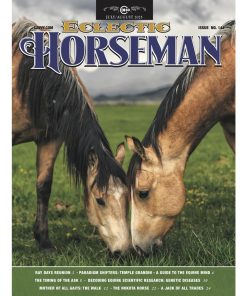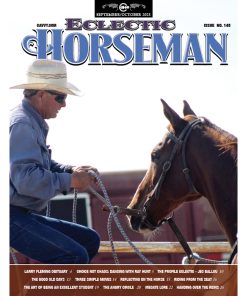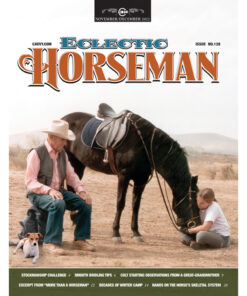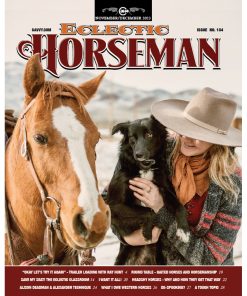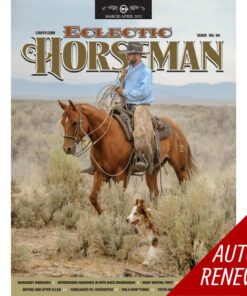This article is from issue No.109
My horse jigs when I’m riding with other horses instead of walking out. How can I work on that?
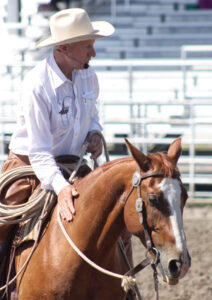 It can be frustrating when you’re out riding with a group and your horse doesn’t walk out. The more your horse jigs, the more the good walking horses leave you behind. The more excited he gets, the more he jigs and pretty soon you’re going nowhere fast.
It can be frustrating when you’re out riding with a group and your horse doesn’t walk out. The more your horse jigs, the more the good walking horses leave you behind. The more excited he gets, the more he jigs and pretty soon you’re going nowhere fast.
I know I need to get a horse ready for that environment. Especially with a colt I wouldn’t expect him to go from not knowing how to walk out to just walking out. I work on things incrementally. I’ll liven up my body first. If that doesn’t work I’ll come in with my legs. That’s plan B. For everything I do I have a plan B. I liven up my body, come in with my legs and I’ll get a change. I’ll build that walk up to where he’s at what I think is a maximum walk. But only maintain it for two or three steps. When he’s a winner, and he’s succeeded, I’ll slow my body down right away and allow him to slow his body down too. Odds are when you’ve peaked him out at the walk he would have slowed down anyway, but I’ll slow him down because I said to.
I’ll let him poke along for a few steps and set it up again: Liven my body, follow up with my legs until I get that peak two or three steps. Pretty soon he’ll realize “If I build that walk up to where I can’t walk any faster, then I get a break.” So I’ve made a winner out of the horse. It isn’t too long until I’ll build that walk up and say, “Okay, but now we need five steps.” And then I’ll slow my body down. I do this 100% of the time when I ride a horse. So eventually you won’t have to think about it.
Pretty soon he can get five steps at top speed. Then naturally I’ll work at slowing him down because I need that too. But pretty soon those five steps turn to 10, 50, 100, 10,000. So everything that I do I allow it to be incremental for the horse so that he can put together what it takes to be a winner.
Most people are greedy. What they do is get after him to get him walking out and when he peaks out, they are still pedaling and pretty soon they just get their horse good at being kicked. So the horse’s take is “well I guess he just wants me to be a punching bag… the signal I got was that he doesn’t want me to do much when he kicks me, just put up with it.” When you get caught in that trap to where you are just pedaling a horse…. It’s less work to walk!
Trotting is great, lots of long trotting. But when you are walking, there is something to do. What a lot of people do is that when they get to the walk they check out. You’re probably just airing up a bit until you can trot again and that’s fine. But nobody said when you’re walking you have to ride poorly. Don’t just let the quality go because you are resting. Maybe I want him to have a medium walk; he needs to follow the life in my body. If my body has the life of a lively walk, he’d better follow that. Pretty soon your horse will feel back to you and they are measuring how much life you have and they will match you exactly. I need to be able to dial that life up and down. Medium and slow are important too.
A slow walk is not a dull horse. It’s relative to what I asked him to do. Sometimes you can walk into a pen of cattle and if your horse walks too lively, they are crawling up the fences. Under those circumstances you need to walk like a ghost so they don’t know you are there. There’s a place for that too.
You have heard me talk about life until I’m blue in the face. If your horse is dull, you can’t get anything done. You need to understand that life in a horse is not speed. Dull horses can go fast. It’s not speed. Life is punctuality at responding to you, and it’s having your horse to where your leg is so light nobody can even see it. That’s life. It’s how little does it take to get him to go, and how little time does it take for him to go. That’s life. It’s not going fast. I’ve seen plenty of dull horses go too fast, but they aren’t light to the leg.
How can I get my horse to lope nice circles?
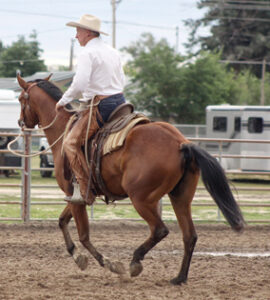 When you watch me ride my colt, because he’s green I do have to trot and lope him every day, but the majority of my “schooling” is at the walk. I’ll do all I can at the walk to get him freed up and with me. That tells me that I’ve checked all the boxes, (See EH #102). It is then reasonable to think he could trot. Then I’ll trot but I’ll keep that as basic as I need to. I might try to do the most difficult thing I can do, but it might only be trotting on a loose rein if he’s real green. Once I’ve done everything I can do at the trot and he’s with me and allowing me to guide him., then I’ll lope him.
When you watch me ride my colt, because he’s green I do have to trot and lope him every day, but the majority of my “schooling” is at the walk. I’ll do all I can at the walk to get him freed up and with me. That tells me that I’ve checked all the boxes, (See EH #102). It is then reasonable to think he could trot. Then I’ll trot but I’ll keep that as basic as I need to. I might try to do the most difficult thing I can do, but it might only be trotting on a loose rein if he’s real green. Once I’ve done everything I can do at the trot and he’s with me and allowing me to guide him., then I’ll lope him.
I’ll follow the same strategy that I told you about for walking a green horse out. I don’t lope circles at first. I trot big circles and I might lope four or five strides. When he’s a winner, he’s still on course and he’s loping, I’m going to slow him back down to the trot, telling him “you nailed it, good job.” Trot a little farther, then go four or five strides again until that’s pretty much perfect. Then it’s onto seven or eight strides.
But what a lot of folks do instead is they lope into trouble. They lope until he comes completely unraveled. Instead of taking an opportunity when he’s still a success to slow him down and let him build on that, they keep loping till they are ass deep in alligators. Then it’s crisis management… one rein stop if you can… You rode him into failure. My colt lopes great circles, but he does because I did it in increments. A few steps at a time. Every time I slowed him down it was because things were going well, not going to hell. Just that simple strategy can help you get a horse loping nice circles.
Now this is the part where people will stick their fingers in their ears and say “la, la la, I can’t hear you.” But…when you are loping your horse if you can’t move him out on a loose rein, on course, with a good cadence… you have no business pulling on two reins. Don’t think I’m anti-collection, not at all. That is the very beginning of loping a green horse, loping on a loose rein on course. So it makes me wonder, why is it if that is as basic as it gets, why is it as soon as most people are loping a horse they are pulling on him. Then they complain about that they can’t get him to go. Well, if you were the horse you would ask, “Why should I? Every time I lope you bash me in the mouth. You wonder why I jump sideways underneath you? There is something up ahead going to punch me in the face… I don’t want to go! Every time we lope, you pull on me.”
So the deal is, once your horse is loping nice circles on a loose rein, then it is appropriate to ask for a soft feel at the lope. But first the loose rein. That box must be checked. So when you do lope it might take all the courage you have to let your horse go on a loose rein. But I didn’t say throw the reins away and hope for the best. If he’s not super reliable you need to be ready to stop with a one rein. He might need a little direction right or left because you can’t keep him on course. But you won’t be pulling on two reins. Bring him up to a lope for four strides, slow him down, get him soft. If you did eight you might be in a wreck. Lope four, bring him down, lope four again. Then you did eight and you survived. You have to get the horse to where you’re making him a winner and not a loser.
Bring horsemanship home. Subscribe today!


